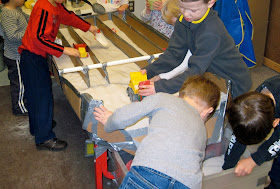I wanted to make something that would take advantage of the flatness of the box. I decided to make something that would fit on top of the sand table. When I say on top, I mean on top of the cover of the sand table. That way the top of the table could give a flat-structured apparatus more strength by serving as the support for the apparatus.
I settled on a channel apparatus. I always think in terms of dimensions; the flat, openess of the apparatus with individual channels offered new and unique dimensions for the children to explore.
If you are looking at it in terms of dimensions, then, you will see the apparatus is very open and has a horizontal orientation. Separate spaces are created by the little cardboard barriers that form the channels. They are long, narrow spaces that are relatively shallow. Since there is a ramp for the sand to slide down, there is an additional level represented by the bottom of the tub. If you take the ramp separately, it is really a continuum of levels.
Just a quick structural note: The sand is quite heavy and without the support of the table's top underneath, the apparatus would sag and loose structural integrity.
The easiest way to make channels is to find a box that already has the dimensions of a channel.
You can see this type of box all the time in the big-box hardware stores.
Cut the top with a utility knife or a box cutter.
Place it in the large, open box and tape in place. I like to keep the end I will be taping to the box intact to give the channel extra strength.

If you don't have a box that has the dimensions of a chute, you can still make one easily. Look for a box that is long and narrow. Measure how long you want the channel and then how high you want the sides of the channel. When you have made your marks cut the box using a utility knife or a box cutter.
To stabilize the channels on the open end, I tape a pvc pipe across the end.
Without the pipe, the channels tend to lean. I have done that before and it does change the space in which the children operate. They can, however, learn that lots of sand can constrict the channels.
The ramp is the most difficult for me to make. I usually tape another open box to the apparatus.
When I do that, I add a triangular cardboard piece on each side to get the slant for the ramp. It is hard to see in this picture because it is completely covered with duct tape, but you can kind of see it in the middle, right?
You could use the apparatus without the ramp and still see unique play on the part of the children.
The ramp, however, has a way of expanding play onto different levels on a continuum bridging the top of the table with the bottom of the tub.
































